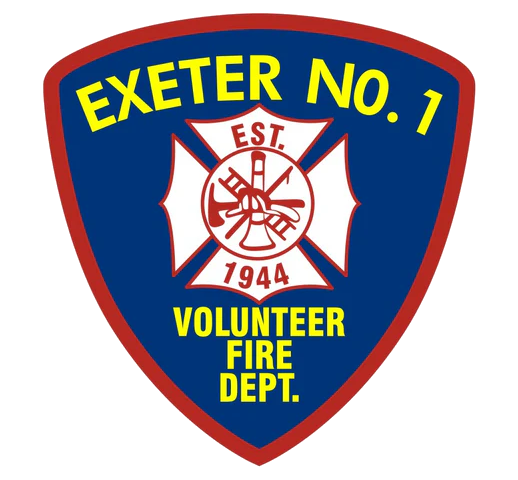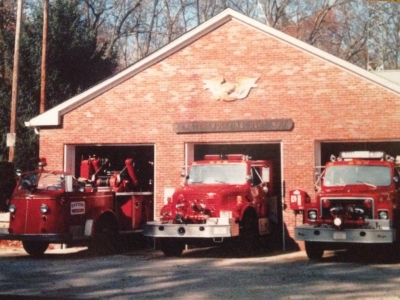In the early 1930’s Reuben Brown was appointed the Town of Exeter’s first Fire Warden. This position was made to oversee and control any wild land fires. To enhance his position, he bought a 1932 Chevrolet and put a wooden box in the back to carry pump cans for use fighting fires.
In 1936, he bought a new 1936 Chevrolet that was bright yellow. He drove it home from John Yemma Chevrolet. This vehicle served dual purpose. It was used as a school bus and could also be converted into a fire vehicle by removing the back seat and installing the old wooden box and pump cans. Later on Reuben’s daughter Ruth painted the car red.
Shortly after this, Reuben bought a 1926 Dodge car from Fred Smith His son painted it red with a broom. They cut the back off and placed a 55gallon drum on the back seat. They would full it with water so they would have a tank car or a tank truck as we say today. The tank would be filled with water and then pressurized with air from a hand tire pump. A valve or faucet was added to the bottom to release the water. This tank was used mostly to supply back packs or tanks.
In 1939 Reuben bought from Oscar Pratt a 1924 Dodge fire truck with a front end pump, ladder rack, hose bed and a small tank. This was the greatest thing since sliced bread. This gave Reuben a real fire truck to go with his status as the Forest Fire Warden.
In 1940 a pig farmer from West Greenwich was burning trash when the fire got out of control. The fire burned across the west end of the town into Hope Valley.
Locust Valley Farm, owned by Grinnell, had a 1932 Model “B” fire truck of its own. They used it to protect their own property. This truck and Reuben’s fire car were the only fire vehicles in the area, so they responded with the 1932 Model “B” along with Reuben’s 1924 Dodge to help put out the fire. Some of the people who responded were Lawrence Records, Bob Fulford, “Red” Anderson, Sidney Ivens, Oscar Pratt, George Barber, and Seldon Barber. The two fire vehicles and men were assisted by other vehicles. One vehicle came from Carolina and their Forestry Department. Fred W. Smith was in charge and called “the Fire Boss”. After the episode the residents involved in the fire suppression decided that they needed to organize a fire department.
The first meeting was in 1940 and was held in the Town Clerk’s Office on Ten Rod Road. After much discussion about the size of the town, it was concluded that one fire company was not sufficient. So the decision was made to have two fire companies with the proposed division line of New London Turnpike.
In 1942, the residence living in the east end of Exeter met in the garage on Locust Valley Farm, this building still exists. They played “Hi-Lo Jack” at a penny a point to pay for the lights, gas, and expenses. This game would draw 15 to 20 firemen or players. As the story goes, Harry Brown would say, “Let’s get this business over with so we can play cards”. Unknown to them, this group of people were starting what is now known as the Exeter Volunteer Fire Department No.1. As time went on they decided on a two dollar per year dues for anyone who wanted to join their group.
In 1943 they purchased a 1938 Ford flat bed and turned it into a vehicle that would last for years. Charles W. Fulford did the mechanical work and the plumping on the truck. Lawrence Records did the body work with his father Harry. This would be retired Chief Harry Record’s father and grandfather. This now gave the group two firefighting vehicles. The barn doors at the Locust Valley Farm had to be revamped to accommodate this growth. This led them to discuss building their own fire station and it’s funding.
The Fire Department was being born, and in 1944 they applied for a charter. This would officially make them the Exeter Volunteer Fire Department. The charter date was February 10th, 1944. The charter members were Joseph Fulford, Willis Kenyon, George Avery, Reuben Brown, Lawrence Records, Harold Barnes, and Sidney Ivens.
The Department elected Rueben Brown their first Fire Chief and Carl Douglas their first Deputy Chief. Deputy Chief Douglas approached Adelbert Slocum about the land where the fire department sits today. Mr. Slocum agreed to donate the land to the fire company to build their first station. This was after they attempted to build on Town property near the Clerk’s Office and struck water in the footings.
In 1947 Joseph Fulford was elected Building Committee chairman and the project began. The building was designed with plans drawn by Ken Arnold. It was designed with a truss roof so it could be raised some day for a hall, kitchen, and meeting room.
In 1949 the fire company moved into their new station with the 1938 Ford. The other bay was rented to raise money to pay the $7,000 cost of construction. As the stories are told around town, the space was leased to the Town of Exeter to garage a school bus.
Sometime before 1950 the department purchased two additional trucks. The first, a 1922 American Lafrance, was called truck 3. Later the Department sold the American Lafrance and purchased a 1936 Mack from the Greenwood Fire Department in Warwick. The Mack would be the last truck purchased for a number of years.
One Evening in the early 1950’s Chief Charles Fulford left “Shrub Hill” Grange Hall after calling square dances. While driving home he noticed people standing outside the fire station watching the 1938 Ford burning inside the station. Chief Fulford opened the door, ran in, grabbed the extinguisher of the truck and put out the fire. The next day he and others proceeded to repair the damage to the truck and put it back in service.
Around 1957 the members decided it was time to purchase a new vehicle, so one meeting Harry Records, Bob Fulford, Bob Brown, and Richard Brown made a motion to purchase a new truck. The older members asked, “Where the money was coming from.”
The Truck Committee, with 1,500 in the treasury, purchased a 1961 international from Farrar Company in Hopkinton Mass. for the sum of $8,685. This was unheard of by the senior members, but through suppers, clambakes, door to door soliciting, and paper drives, they raise $4,000. Rosa Grinnell Matterson of Locust Valley understood their plight and donated the balance of $4,200 to pay off the loan.
During these early times one would winder how you would get people’s attention without today’s telephone and radio systems. They were innovative. If the first phone rang in Reuben Brown’s home on the farm, Mrs. Brown would go outside and bang the bell hanging from a tree that would echo throughout the valley. They workers heard the noise and they chase would be on.
In the mid 1940’s a “Red Network” system was installed by the telephone company. This was a system of five to six red phones that could be answered only. These phones were placed in private homes and were answered when there was a fire. Each home had a list of firemen to call. If you were to be on vacation or away for any reason, you would have to call one another to make sure your list would be notified in case of a fire. Many weekends and cookouts were passed by in the spring to “baby-sit” the “Red phones” during fire season.
This system was in use until Paul Barnum devised a system of electronics. This radio system would put out a funny tone tripping a home radio receiver. And give the message. This was the first system of this nature even attempted in South County. It had its skeptics. Under Paul Barnum and Donald Fulford’s direction, a cable was run from the fire station up Ten Rod Road to the home of Donald Fulford and one to the home of Harry Records. The first two dispatchers were Audrey Records and Florence Fulford. They system worked well and started to improve the response time of firemen.
In 1964 Engine 7 was purchased from the NY Pipe Line as a cab and chassis. Farrar Fire Equipment was hired to equip the truck for $3,500. Engine 7 was the department’s first four wheel drive truck. A winch was removed from the old truck at Ladd School and mounted on the rear of Engine 7.
In 1966 a 1958 Dodge Tank truck was given to the Town by the Civil Defense through the efforts of Julian Hanks and Oscar Swanson.
In 1967 Farrar and Co. was hired to paint and install a new front end pump, roof revolving light, and rear warning lights on the 1958 Dodge tank truck. The truck was also equipped with hand lights and a 250 gpm pump. The total cost was $3,296.
In 1968 the Department received its first FCC license to operate it’s own radio system. The license number was KLE840.
In 1973 a committee was established to look into building an addition on to the station. By November another committee is formed to draw outside dimensions on the land and check on purchasing additional land. Harry Records, Oscar Swanson, and Thomas Martin are assigned to the committee. In November, Oscar Swanson reported that the estimated building cost would be $5,867.
In 1974 Chief Records reports that Domenic Vendresca will donate 50 feet of land on either side of the fire station to the fire department. Later in July the draft plans for the addition went to the body for review. The new addition will house a social hall, kitchen, boiler room and two bathrooms. The plans were approved and the project went forward.
In 1976 the radio “C” codes were changed. Engine and Tanker would now be used to identify trucks.
In 1979 the truck committee submitted a motion to purchase Engine 8 for $59,875 from Farrar and Company. Treasurer Oscar Swanson negotiated a loan with Farmers Home for the new Engine 8.
In 1981 Rodman Jordan was elected Fire Chief and has since become the longest running fire chief for the department.
In 1984 a discussion is held regarding building a substation. The truck and building committees will work together and look for property between harbor shellfish and palmer grove trailer park.
In October of 1987 the truck committee submits a motion to buy a new pumper truck from ranger for $90,725. This truck will replace the current Engine 6 and carry the same name. Old Engine 6 will be renamed Engine 5.
In June of 1988 the fire department purchases its first set of Jaws of Life with a grant of $8,000 from the state, the jaws arrived in September and were placed on Engine 6.
In 1990 the fire department purchases its first cascade system for filling our Scott air bottles, we will no longer have to send our bottles out of town to be filled. In September the truck committee gave an overview on the new 3000 gallon tank truck they have been designing.
In January of 1991 a municipal fire alarm system was purchased and the first radio signal box was installed in the Ladd Center Marathon House, Box 501. In July the motion was made and passed to purchase a new tank truck from E.J.Murphy for $138,166.
In 1992 he bid was awarded to construct the substation for 110,397. Construction is to begin in March. In August the substation is completed and named Station 4. In June the department purchased a diesel fuel tank for filling the trucks. The department also acquires the old ladder truck from Quonset Point. The truck is housed at station 1 and named ladder 6.



